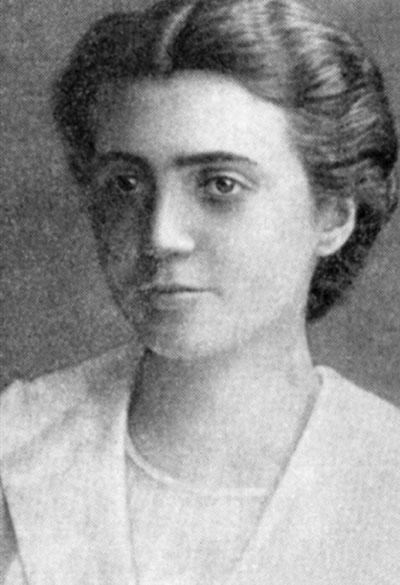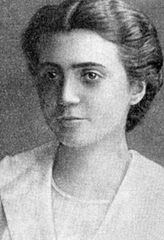Name Lucja Frey | ||
 | ||
ucja frey
Łucja Frey or Łucja Frey-Gottesman (November 3, 1889 in Lwów – 1942?) was a Polish physician and neurologist, known for describing the syndrome later named after her. Łucja Frey was one of the first female academic neurologists in Europe. She perished during the Holocaust in 1942 in Lwów ghetto aged 53.
Contents
Life

Łucja Frey was born on November 3, 1889 in Lwów, then part of the Austro-Hungarian empire, as the daughter of the building contractor Szymon Symcha Frey and his wife, Dina (née Weinreb) Frey and her family were Jewish. She attended a Christian elementary school between 1896 and 1900. She graduated from Franciszek-Józef secondary school as an extern pupil in 1907. After graduation she studied mathematics and philosophy under professor Marian Smoluchowski (1872-1917). She was a student of the faculty of philosophy from 1907 to 1912, but after five years she moved to Warsaw and began studying medicine.
Frey studied medicine from 1918 to 1923 and received her medical diploma on June 2, 1923. Her studies were interrupted for one year because of the Polish–Ukrainian War.
After graduation she continued her work as a senior assistant to professor Kazimierz Orzechowski (1878–1942) in his Warsaw neurological clinic. At the end of 1928 she left Warsaw to go back to Lwów, and married a lawyer named Mordechai (Marek) Gottesman (1887 in Komarno – 1941?). From May 1929 she was working at the neurological clinic in Lwów on Rappaporta Street as a deputy senior consultant. She gave birth to her daughter, Danuta, in 1930.
After the Soviet invasion of Poland on September 19, 1939 and the subsequent occupation of Lwów, Mark Gottesman was accused of counter-revolutionary activities and was arrested by the NKVD; nothing is known about him after this point. In 1941, under the German occupation of Lwów, Łucja Frey was resettled to the ghetto and forced to work in Ghettopoliklinik in Zamarstynowska 112. She was probably murdered together with her patients during liquidation of the ghetto in August 1942 or shortly after deportation to Belzec extermination camp. No evidence exists, that she, or any of her relatives, survived.
There are many uncertainties about her life. According to Yad Vashem testimony of Hedwa Balat, Frey's sister-in-law, Łucja and Marek had a son named Jakub, born in 1919. However, no other sources support this thesis and Frey's biographer finds it very unlikely.
Recognition
Until 2004, only short biographic articles about Łucja Frey's life existed: in Polish, Swedish, and English. These publications repeated fragmentary and scarce facts from Eufemiusz Herman's classic monograph about Polish neurologists. New facts about her tragic life were published in Mirjam Moltrecht's biography. However, Frey's name is often omitted or misspelled (as "Lucy" or "Lucie") in many textbooks and dictionaries. Dates of birth and death of Austrian physician and physiologist Maximilian Ruppert Franz von Frey (1852-1932) were sometimes mistakenly given as hers.
Works
Frey's publication about auriculotemporal nerve syndrome, now widely known as "Frey's syndrome" ("zespół Łucji Frey" in Polish), was published in 1923, first in Polish journal "Polska Gazeta Lekarska", and later that year in renowned French journal "Revue Neurologique". It was not the very first description of this constellation of symptoms. Frey's predecessors were Kastremsky (1740), Duphenix (1757), Barthez (1806), Dupuy (1816), Brown-Sequard (1849), Baillarger (1853), Henle (1855), Berard (1855), Bergounhioux (1859), Rouyer (1859), Botkin (1875), Parkes Weber (1897), New and Bozer (1922) and Lipsztat (1922). Interestingly, both Brown-Sequard and Henle reported their own symptoms. All these observations lack a wide view of the anatomy, pathology and exact mechanism of gustatory sweating. Łucja Frey's article "Przypadek zespołu nerwu usznoskroniowego" ("Le Syndrome du Nerf Auriculo-Temporal") is considered to be the first such description of the phenomenon. Frey was first to recognize this syndrome as a disorder of both sympathetic and parasympathetic innervations.
The eponym "Frey syndrome" was introduced to medical literature by Henryk Higier in 1926 and in 1932 by Bassoe. In recognition of earlier descriptions of this syndrome, it is also sometimes called Baillarger's syndrome, Frey-Baillarger syndrome or Dupuy syndrome.
Besides this important work, Frey published papers on the effects of vegetable poisons on spinal cord degeneration, brain stem topography, amyotrophic lateral sclerosis, Charcot joints, aneurysms of the plexus of the medulla, cysts of brain ventricles, clivus tumors, frontal lobe tumors and retrosplenial tumors.
